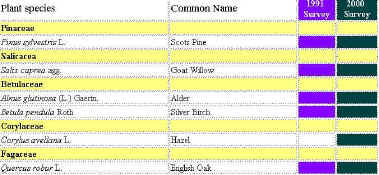|
Offwell Wetland Survey
Comparison of Species
Lists from the Wetland Surveys 1991 and 2000
(Continued)
A number of points emerge from comparing the two species lists generated by the 1991 and
2000 surveys. These are continued from a previous page below. 3.
Differences between the surveys
(continued)
- Mosses
Thirteen mosses were recorded in the 2000 survey, in contrast to only three
in the 1991 survey. This is likely to be partly due to the difference in the methods of
surveying, in that the 2000 survey was far more comprehensive. However, it is also likely
to reflect real differences in the amount and number of moss species present in the
wetland nearly ten years after the first survey.
Soon after restoration, there would have been little time for mosses to recolonize the
disturbed ground in the wetland. What moss there was would probably have covered a very
small area and was likely to have been fairly inconspicuous. Nearly ten years later,
mosses have had plenty of time to become well-established in the wetland.

|
Most of the moss species are found in the wet woodland margins of the wetland. The species
here are typical of damp woodlands in general. Only four species colonized substantial
areas in the marsh zone of the wetland. These were, in order of dominance, Eurhynchium
praelongum, Brachythecium rivulare, Thuidium tamarascinum and Sphagnum
subsecundum. Brachythecium rivulare and Sphagnum sebsecundum are
both characteristic of marsh areas, whereas Eurhynchium praelongum and
Thuidium tamarascinum are commonly encountered in most woodlands, but also have marsh
forms. Eurhynchium praelongum was the only moss to occur in the swamp zones. Here
it could be found clothing the bases of plant stems. |
Brachythecium
rivulare in the marsh area |
|
|
Before and After A
comparison of the wetland before restoration and nearly ten years after restoration.
|

